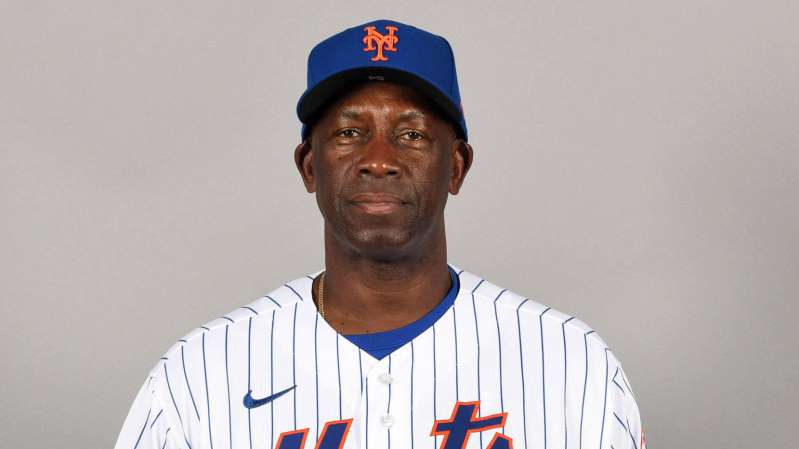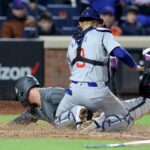
Mets hitting coach Chili Davis spoke to the media on Wednesday in the same way he has been with his players over the past month: via Zoom.
Davis, in his second season with the Mets, spoke from his home in Arizona where he has been since spring training was shut down in March. Due to the ongoing threat of COVID-19 and underlying health conditions, he doesn’t know when he will re-join the team in New York, or if he will at all.
And though the 60-year-old baseball lifer has been in constant contact with his hitters, he described recent weeks as extremely difficult.
“It was a tough decision,” Davis said. “It gets even tougher watching the two Yankee [exhibition] games. Each time I talk to someone there or I’m on a Zoom call, it’s just really tough to do because I’m used to being around those guys.
“It’s kind of boring sitting here not doing what I signed up to do. It’s not easy at all.”
Davis’ daily routine involves multiple phone calls with manager Luis Rojas and assistant hitting coach Tom Slater, who is the on-site lead instructor. Mets manager of video operations Joe Scarola sends clips from batting practice, intrasquad games, and cage sessions.
When he needs to speak with a player directly, Davis has to figure out the best time to talk. It isn’t ideal.
“It’s not smooth, believe me,” he said. “Trying to reach players via What’s App, text message, or phone — it’s different. I’m hoping that it will get easier — I don’t think it will — as we go.”
Davis has also been preparing advance scouting reports for the first series of the shortened season against the Atlanta Braves. That’s a task he would usually do at the ballpark but it becomes much more difficult without direct access to the Mets’ in-house computers. Baseball research and development analyst Jared Faust has been sending Davis as much information as he can.
“It’s different, but I have to do what I have to do.”
In addition to talking about his new daily routine, Davis offered extensive thoughts on some of the Mets’ most important bats.
Pete Alonso
“Pete and I had a long conversation, not yesterday but the day before, just reminding him that the guy that hit 53 home runs last year wasn’t just the guy that finished in the second half. The guy that 53 home runs last year was the guy that started from spring training to the all-star break.
“I thought he had a few more ups and downs in the second half than he had in the first half. Pete would admit it. He went to the All-Star Game, and he did some great things last year, played in the All-Star Game, won a Home Run Derby title in his rookie season, and when you do things like that as a young player you come back the second half and feel like you have to match what you did in the first half.
“The guy that set up that 53-homer year was the guy from spring training to the all-star break. What I liked about that guy, and Pete and I talked about this, was from me coming in and not knowing him — I heard a lot of things about him, the big thing was [the 36 home runs he hit in the minors in 2018], big first baseman — and I thought I was going to see this slugger that just swings as hard as he can and all he thinks about are home runs.
“On the contrary, I met a guy that was very disciplined in his work. I told him in spring training, ‘you look like a little man in a big man’s body.’ He was hitting line drives, he was hitting diligently, and he took it into the opening series against Washington and throughout the first half. And his approach was very simple.
“The one thing we talk about mostly is, number one, you can’t match those numbers you put up last year in a 60-game season, so you’ve got to keep the approach as simple as possible.
“And the second thing I wanted him to understand is ‘don’t put in your mind that pitchers aren’t going to pitch to you. They are, and you’re a fastball hitter, you hit bad breaking balls not good ones. So work off the fastball, and if you’re doing that you’ll recognize the hittable breaking balls.'”
“If Petey stays on the fastball and they make mistakes with breaking balls, he’s going to hurt them. And if he stays on the fastball and they throw chase breaking balls, he’s going to eliminate chasing those pitches.
“Sometimes the problem is, and I’ve gone through this, if you look for breaking balls you get breaking balls, and because you’re looking for them you recognize them so soon and you start going out to get them.
“And he works off the breaking ball machine, he works very hard.”
Yoenis Céspedes
“First, I’m just really happy to see him back out there. He’s moving around a lot better than in the first spring training. I think he’s swinging the bat well.
“I’ve spoken with Ces a couple times, just watching his swings and watching his approach. I caught him in the cage with [hitting performance coordinator] Ryan Ellis the last time I spoke to him and we went over his routine, the whole purpose of his routine.
“We’re trying to get him back doing the things that make him who he is. I’m really pleased to see him back on the field. He can be a force in that lineup.”
“There is nothing in this world that I believe Cespedes cannot do on a baseball field. He’s proven that to me already. He’s a very determined young man, he’s a very proud young man. So when he makes up his mind that he’s going to go out and prove to the world what he can do he’s going to do that.
“I just hope he stays healthy and if he does he’s going to be a huge benefit to that ballclub.”
Michael Conforto
“Mike is one guy that I don’t worry about.
“I was fortunate during this break to spend a lot of time with Mike in Arizona. He moved to Arizona after the season last year, so I had the opportunity to be with him. I talked to Mike quite a bit.
“I was expecting Mike to come into the 2020 season and really have a big year, based on what I saw him do last year and the work that he did in the first spring training. He was working so well and then the season got cut short.
“I think Mike is a good hitter. He’s got power all over the field. Like any other hitter, when he stays on the field and stays with the line drive approach, then his power shows up. And he does have power from left-center all the way to the right field corner.”
Jeff McNeil
“Mac is a swinger and he’s a hitter. He can do some damage if you make mistakes to him, he can run, he can hit for an average. He’s just a natural hitter.”
“I don’t mind when Mac thinks power, because he does have some power in that little body of his, but I prefer to see him use the whole field. When he’s doing that, pitchers tend to make more mistakes with him and then that power shows up.
“Mac is such a good hitter. Sometimes he fights himself because he knows how good of a hitter he is. Most of the times he makes [an] out, I don’t think pitchers get him out. I think Mac gets himself out.
“He’s a quality hitter, and it’s nice to have that power at the top of the lineup because that does put some fear of that 1-0 lead in the pitcher’s mind.”
Brandon Nimmo
“He has such good plate discipline. He’s going to see a lot of pitches and he’s going to walk a lot. I think he’s gotten to be a little more aggressive from the second half of last year into this year, and I like that about him.
“He’s still a very patient hitter. Not only for his sake, but seeing a lot of pitches helps the guy behind him to also see a lot of pitches. So he’s going to benefit the team that way.”
Amed Rosario
“Rosie proved last year that he can [hit leadoff]. He had a really nice last year, especially in the second half, and he proved that he can do it.
“That’s the luxury we have on that team, because if Rosie is hitting ninth, he’s the guy that starts that whole lineup again at the back of the lineup. If he’s on base then you have Nimmo or Mac or someone coming up after him.”
“I think he just needs to continue doing what he did in the second half last year. I think he prepared very well. He came into the video room prior to batting practice, he sat in the room, he looked at not only the starting pitcher that night but the whole pitching staff that he might have to face during the course of that game or series.
“He took notes on them, he built a gameplan based on what he saw, and he went out and executed that gameplan. His preparation was much improved last year and I think that’s part of the reason you saw his chase numbers go down, the quality of his at-bats get better.
“I think it was mostly the preparation and the fact that he wasn’t trying to be a power hitter. He accepted the fact that he was a line drive hitter and used the whole field. The next step for him is just going to happen if he keeps putting in the work and remaining disciplined at the plate.
“He does have power. Rosie to me has the quickest hands of any hitter on that team. So he doesn’t need to jump out and chase. He can stay behind the ball and still produce enough bat speed to hit the ball hard and use the whole field.”














